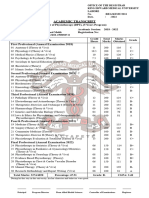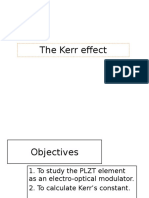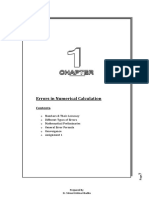DPP - 04 Quantum Chemistry
DPP - 04 Quantum Chemistry
Uploaded by
anurag pandeyCopyright:
Available Formats
DPP - 04 Quantum Chemistry
DPP - 04 Quantum Chemistry
Uploaded by
anurag pandeyOriginal Title
Copyright
Available Formats
Share this document
Did you find this document useful?
Is this content inappropriate?
Copyright:
Available Formats
DPP - 04 Quantum Chemistry
DPP - 04 Quantum Chemistry
Uploaded by
anurag pandeyCopyright:
Available Formats
CSIR-NET|IIT-GATE|IIT-JAM |Other Msc.
Entrance
DPP - 04 QUANTUM CHEMISTRY
1. If Lˆx ,Lˆ y ,Lˆz are the components of the angular momentum operator in three dimensions the commutator
Lˆ x ,Lˆ x Lˆ y Lˆ z may be signified to
(a) iL x Lˆz Lˆ y
2
2
(b) iLˆzLˆyLˆ x
(c) iL x 2Lˆ z Lˆ y
2 2
(d) 0
2. If L x ,L y and L z are respectively the x ,y and z components of angular momentum operator L. The com-
mutator L x ,L y ,L z is equal to
(a) i L x L y
2 2
(b) 2iL z
(c) i L x L y
2 2
(d) 0
3. The linear momentum of a particle decribed by the wavefunction eikx is
(a) kh (b) – kh (c) kh / 2 (d) kh / 2
4. Consider the statements
(i) the expectation value of a Hermitian operator is real and that of an anti-Hermitian operator is imagi-
nary
(ii) anticommutator {A, B} is defined by AB-BA †
ˆ ˆ Bˆ † ,Aˆ †
(iii) Hermitian conjugate of a commutator is A,B
The correct statement above are
(a) (i) (b) (i), (ii) (c) (i), (iii) (d) (i)
5. The correct statement among the following is (A is hermitian operator)
(a) The eigen value of A2 can be negative
(b) The eigen value of A2 are always positive
(c) No eigenfunction of A is an eignfunction of A2
(d) The eignvalue of A2 can be complex
6. Which of the following is common eignfunction of d/dx and d2/dx2 operators
(a) cos x (b) kx (c) eix (d) e – x2
7. For a hermitian operator A, which does not commute with the Hamiltonian H, let 1 be an eignfunction
of A and 2 be an eignfunction of H. The correct statement regarding the average value of commutator
of A with H([A,H]) is
(a) both < 1 A,H 1 and 2 A,H 2 are non zero
(b) only 1 A,H 1 is zero, but 2 A,H 2 is non zero
(c) only 2 A,H 2 is zero, but 1 A,H 1 is non zero
(d) Both 1 A,H 1 and 2 A,H 2 are zero
Address : 50 Mall Road, 1st Floor, GTB Nagar Metro Station Gate No 3, Kingsway Camp, GTB Nagar, New Delhi, Delhi 110009
Contact Us : 9990382567, 7082062392, 9717373074, 8285815185
DPP-(4) / QUANTUM CHEMISTRY
8. A set of N vectors X1, X2 ....... Xn satisfy the eigenvalue equation for an operator A with scalar eigenval-
ues 1 , 2 ,......n (i.e., AXk kXk ) . The linear combination of vector X Ck Xk , where Ck are non-
zero scalar coefficient.
(a) is not an eigenvector of A
(b) is an eigenvector of A only if the k are all distinct (no two eigenvalues are equal)
(c) is an eigenvector of A only if the k are all equal
(d) is an eigenvector of only if Ck are equal
9. The eigenfunctions of the Hamiltonian H (H = T + V) of a harmonic oscillator are (where T and V are
kinetic energy and potential energy operators respectively)
(a) eigenfunctions of T as well as V (b) eigenfunctions of T, but not of V
(c) eigenfunctions of V but not of T (d) eigenfunctions of neither T nor V
10. Which of the following statement is not true
(i) The state function (x,t) is always equal to a function of time multiplied by a function of coordinate.
(ii) If f1 and f2 are eign functions of operator B then C1 f1 C2f2 must always be an eignfunction of B,
where C1 and C2 are constants
2
(iii) The operator L commute with L x L y .
(a) (i), (iii) (b) (i), (ii) (c) (ii), (iii) (d) only (iii)
11. When the operator d
2 2
/ dx 2
operates on a function e ikx
the result is
(a) k 2 2e ikx (b) i k 2 2e ikx (c) i 2e ikx (d) 2e ikx
12. If an operator d / dx 16x is operated on an function e
2 2 2 2 x2
than corresponding eigenvalue is
(a) –2 (b) –4 (c) 2 (d) 4
h / 8 md / dx h x / 2 me x2 2
13.
2 2 2 2 2 2 2 2
C h2 / 4 2 ex h, , ,m constant , value of
C is
(a) 2 /m (b) / 2m (c) / m (d) 2 / m
14. The probability of finding the particle in a one of dimensional box of length ‘L’ in the region between
L 3L
and for quantum number n = 1 is
4 4
1 1 1 1 1 2
(a) (b) (c) (d)
2 2 2 3
15. <x> in the ground state for a particle that is confined to move in a one d box of length -L to L is
(a) L (b) L/2 (c) –L (d) 0
××××
ANSWERS
1. (a) 2. (c) 3. (c) 4. (c) 5. (b) 6.(c) 7. (d)
8. (c) 9.(d) 10. (c) 11. (a) 12. (b) 13. (c) 14. (b)
15. (d)
Address : 50 Mall Road, 1st Floor, GTB Nagar Metro Station Gate No 3, Kingsway Camp, GTB Nagar, New Delhi, Delhi 110009 [2]
Contact Us : 9990382567, 7082062392, 9717373074, 8285815185
You might also like
- Uottawa - Releve de Notes Non Officiel - Unofficial Transcript-6753541 PDFNo ratings yetUottawa - Releve de Notes Non Officiel - Unofficial Transcript-6753541 PDF4 pages
- Western Michigan University Unofficial TranscriptNo ratings yetWestern Michigan University Unofficial Transcript7 pages
- Engineering Mathematics by Stroud K A Bo PDF100% (1)Engineering Mathematics by Stroud K A Bo PDF4 pages
- 7.atomic and Molecular Physics - NET-JRF - VKSNo ratings yet7.atomic and Molecular Physics - NET-JRF - VKS17 pages
- Biochemical Tutorial Calculation QUESTIONSNo ratings yetBiochemical Tutorial Calculation QUESTIONS9 pages
- Mechanics of Materials - I Semester 2 BSC Mechanical Engineering Uet Peshawar, PakistanNo ratings yetMechanics of Materials - I Semester 2 BSC Mechanical Engineering Uet Peshawar, Pakistan22 pages
- Thermodynamics Definition, Formulas, Laws and Equations - PhysicsNo ratings yetThermodynamics Definition, Formulas, Laws and Equations - Physics7 pages
- Solutions Manual For A First Course in Mathematical Modeling, 5e Frank Giordano, William Fox, Steven Horton50% (2)Solutions Manual For A First Course in Mathematical Modeling, 5e Frank Giordano, William Fox, Steven Horton14 pages
- Hampton Inn & Suites Kittery-Portsmouth8 5 2024 2922649832No ratings yetHampton Inn & Suites Kittery-Portsmouth8 5 2024 29226498321 page
- University of Bahrain Department of Mechanical Engineering MENG 263 TUTORIAL # 4 (Chapter 3)No ratings yetUniversity of Bahrain Department of Mechanical Engineering MENG 263 TUTORIAL # 4 (Chapter 3)5 pages
- AP Physics C E&M Unit 3 1. Magnetic Field and Force Homework SolutionNo ratings yetAP Physics C E&M Unit 3 1. Magnetic Field and Force Homework Solution6 pages
- Advanced Algebra and Functions: Sample Questions100% (1)Advanced Algebra and Functions: Sample Questions10 pages
- Maths Presentation: Chapter#1 Limits and FunctionsNo ratings yetMaths Presentation: Chapter#1 Limits and Functions11 pages
- Comedk 2019 Question Paper With Answer KeyNo ratings yetComedk 2019 Question Paper With Answer Key52 pages
- Black Board Problems For JEE Advanced 2022 Set-2No ratings yetBlack Board Problems For JEE Advanced 2022 Set-27 pages
- Get Water Supply Engineering Volume - 1 Dr. P.N. Modi PDF ebook with Full Chapters Now100% (5)Get Water Supply Engineering Volume - 1 Dr. P.N. Modi PDF ebook with Full Chapters Now37 pages
- Chapter 7. Griffiths-Electrodynamics 7.3No ratings yetChapter 7. Griffiths-Electrodynamics 7.316 pages
- Academic Transcript: Taylor D. Adkins ReturningNo ratings yetAcademic Transcript: Taylor D. Adkins Returning12 pages
- Black Board Problems For JEE Advanced Set-8No ratings yetBlack Board Problems For JEE Advanced Set-87 pages
- Department of Mathematics: University of Rajshahi Rajshahi-6205, BangladeshNo ratings yetDepartment of Mathematics: University of Rajshahi Rajshahi-6205, Bangladesh23 pages
- Practice Sheet (Rotation, SHM) Question PaperNo ratings yetPractice Sheet (Rotation, SHM) Question Paper8 pages
- Inmo-2012 Previous Year Question Papers of Indian National Mathematical Olympiad (INMO) With SolutionsNo ratings yetInmo-2012 Previous Year Question Papers of Indian National Mathematical Olympiad (INMO) With Solutions6 pages
- DPP - 02 Quantum Chemistry: CSIR-NET - IIT-GATE - IIT-JAM - Other Msc. EntranceNo ratings yetDPP - 02 Quantum Chemistry: CSIR-NET - IIT-GATE - IIT-JAM - Other Msc. Entrance2 pages
- Csir-Ugc-Net/Jrf - June - 2015: F T With Time Period T As Shown in The Figure BelowNo ratings yetCsir-Ugc-Net/Jrf - June - 2015: F T With Time Period T As Shown in The Figure Below10 pages
- F-16 Chip Resetter Operating InstructionsNo ratings yetF-16 Chip Resetter Operating Instructions6 pages
- Negative Mass: by Robert Nemiroff Michigan TechNo ratings yetNegative Mass: by Robert Nemiroff Michigan Tech11 pages
- Oracle Database 21c Enterprise Edition Release 21No ratings yetOracle Database 21c Enterprise Edition Release 2125 pages
- Ahu-01 Io List: Channel Description Tag Name Micro ArrayNo ratings yetAhu-01 Io List: Channel Description Tag Name Micro Array9 pages
- Numerical Study on the Automatic Ballast Control of a Floating DockNo ratings yetNumerical Study on the Automatic Ballast Control of a Floating Dock12 pages
- Complete vs. Incomplete Information GamesNo ratings yetComplete vs. Incomplete Information Games8 pages
























































































